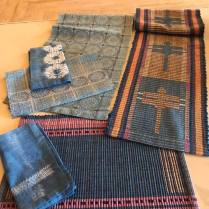View the beautiful projects created by our guild members here:
2024 Guild Scholarship Winners!
Columbia Fibres Guild
Aurora Colony Spinners Guild
Heritage Textiles Guild
Saturday Handweavers Guild
Congratulations, each guild will received $500 towards fiber education activities.
Filaments Traveling Show 2023

Please click here to see the pictures, of the entries for this years show.
WeGO Scholarship Winners 2023
Clatsop Weavers & Spinners Guild
Eugene Weavers Guild
Klamath Spinners & Weavers Guild
Webfoot Weavers & Fiber Artists Guild
People’s Choice Award Winner – 2018 WeGO Traveling Show ~
Peacock Feathers Shawl by Corienne Geddes

Spring 2023 Show & Share
See all the beautiful pictures, from various guilds here.
Color to Dye For with Judith Mackenzie -Workshop
By Carolee Kirkelie, Central Oregon Spinners & Weavers Guild
September 6, 2018
A day spent with Judith Mackenzie is a day to be treasured. The consummate fiber artist exudes warmth and knowledge while captivating her students at every word. Judith’s work can be found in her extensive books and DVDs; however the in-person, up front Judith is even more amazing! Our day was a focus on weak acid super milling dye, primarily for both color fastness and economic benefits.
We began by soaking our yarn and roving with a surfactant, Dawn dishwashing liquid, to ensure oils and dirt are removed and the dye will be taken up fully without resistance. Dawn Free and Clear was suggested, and a reminder to never dye in the grease.
Our palette begins with the classic three colors of yellow, magenta and cyan. There was also a black or neutral color to change tone; just as in watercolor painting, the principles are interdisciplinary for mixing an extended palette of secondary colors. Our process starts simply with a quart canning jar two thirds filled with cold water and a glug of white vinegar. We each will have a jar of our own color choice and mix efforts. Judith emphasizes the high tech measuring of ingredients; a pre-moistened chopstick tapped into dye powder is her instrument of choice. Precision is everything! Mix ratio to target is ~4 grams/saturated 1 lb. of fiber. Her process, a wet chopstick in hand, could probably not be more accurate. Again the pragmatic and ever simple approach is not lost on her students.

Once the water, vinegar and dye powder is mixed to that perfect color, we then place our yarn into the jar; the goal is to have a full jar of liquid with yarn fully immersed. Then put the lid and ring on, while placing the jar into a Ball electric water bath canner. With canner lid in place and temperature set to medium the jars of wool will come up to heat and maintain temperature for approximately 45 mins. One can of course use a more conventional canner approach on the burner; however the electric bath canner comes up to speed rapidly, is a very safe and efficient process to follow.
We experimented with both undyed and previously dyed yarn or fleece that was brown. It was fascinating to see the opportunities to over dye whether unplanned or by design, it increases possibilities for mono color or multi-color spun yarn to make changes. So do you have some ugly yarn? Change it by overdyeing!
The remaining time together was spent exploring indigo, Instant Indigo otherwise known as freeze dried indigo, and learning all the ins and outs with a practical approach to mixing. We also explored a black walnut dye bath as well as the how-to for lichen and cochineal.
All along the way Judith imparts her worldly learnings, insight and humor. She’s quick witted and doesn’t miss a beat as questions run the gambit of all things wool, protein, amino acids, plant fiber, origins and end uses. You swiftly realize that Judith has gone there…like trying to grow nettle, which requires a picky soil and location preference that did not allow it to be transplanted keeping its use to that where it’s found. Nettle you see made the strongest woven nets for fishing. Judith MacKenzie the teacher of old and new world ways for dyeing, antidotes for fiber and life, a rich and mind expanding experience should not be missed.












